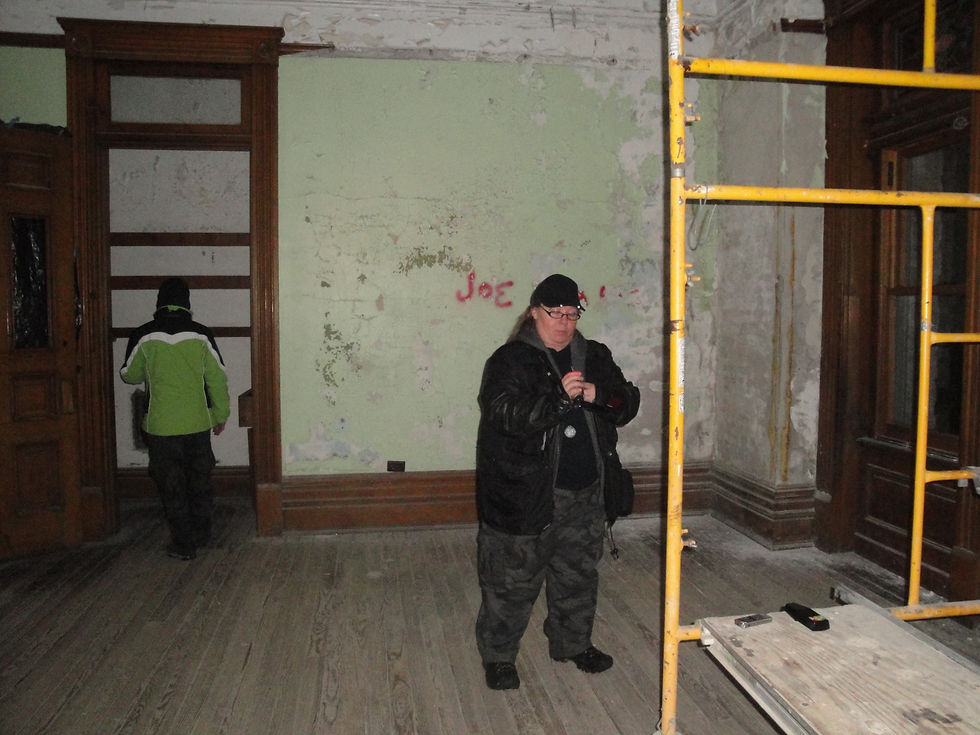



OHIO STATE REFORMATORY Investigation 11/18/14 - Mansfield, Ohio
HISTORY
The cornerstone laid on November 4, 1886 evolved into this magnificent Chateauesque structure. Cleveland architect Levi T. Scofield designed the Ohio State Reformatory using a combination of three architectural styles; Victorian Gothic, Richardsonian Romanesque and Queen Anne. This was done to encourage inmates back to a "rebirth" of their spiritual lives. The architecture itself inspired them to turn away from their sinful lifestyle, and toward repentance.
The Reformatory doors were opened to its first 150 young offenders in September 1896. After housing over 155,000 men in its lifetime, the doors to the prison closed December 31, 1990.
Today, the Ohio State Reformatory Historic Site receives visitors from all over the world. Every year tourists, movie buffs, thrill seekers and paranormal investigators walk through the halls of this majestic structure.
One of the state of Ohio's greatest buildings is still standing just outside Mansfield: the old State Reformatory. Drive past it and you'll be amazed that such a place exists outside of Transylvania, or someplace dark and gothic like that. No wonder it's been used as a set for four movies (Harry and Walter Go To New York, Tango and Cash, Air Force One, The Shawshank Redemption) and music videos (such as "Awake" by Godsmack; Marilyn Manson has done photography here). Naturally, it's also about as haunted as a single place can be.
In 1885 Mansfield was officially selected as the site for the new Intermediate, and construction began with Levi T. Scofield as head architect. His design was intended to represent Cathedral style, in the hope that the inmates might be inspired to be better people, or something like that. No matter what his intention, it ended up looking incredible--Dracula's castle in northern Ohio. Work was delayed in 1888-1890, but on September 15, 1896, the building was opened as the Ohio State Reformatory. The first 150 prisoners were brought by train from Columbus and put immediately to work on the prison sewer system and the 25-foot stone wall that surrounded the 15-acre complex. It wasn't until 1910 that the building was completely finished. Today OSR houses the world's largest free-standing cell block--six tiers high.
There were a few famous prisoners over the years at OSR. Henry Baker went on to achieve notoriety as a member of the Brinks Gang in the 1950s. Gates Brown, who served a year from 1958 to 1959, would later play baseball for the Detroit Tigers. And in 1989 Kevin Mack, star running back for the Cleveland Browns, did a month on drug charges.
As with any prison, OSR accumulated its horror stories over the years. Two corrections officers lost their lives at OSR; one in 1926, shot to death by a former inmate who was trying to spring his buddy; the other in 1932, beaten to death with a three-foot iron rod in the Hole--slang for solitary confinement. n July of 1948, two inmates released from the Reformatory for "good behavior" displayed some very bad behavior when they went on a killing spree. Robert Daniels and John West, dubbed the "Mad Dog Killers" by the papers, first murdered Columbus tavern owner Earl Ambrose, then stole a car and drove to Mansfield, where they kidnapped OSR farm superintendent John Niebel, his wife, and his twenty-year-old daughter. They murdered all three in a cornfield off Fleming Falls Road. The next day they killed a farmer from Tiffin, whose new bride managed to escape, then shot a truck driver. Two days later the two ex-cons were trapped at a roadblock near Van Wert. West died in a shoot-out with police but Daniels was captured. He bragged about the possibility of dying in the electric chair. The following January he got his wish at the State Pen in Columbus.
On November 6, 1950, the wife of the prison superintendent (Helen in the video below) apparently knocked a loaded gun off a closet shelf and shot herself through the left lung. The next day she died in the Mansfield hospital. It's possible that the superintendent shot her in order to spare himself the messy legal work and political stigma of a divorce. In February 1959 the superintendent himself died from a heart attack in his office.
An inmate hung himself in his cell in 1955. One burned himself to death in his cell with turpentine and paint thinner stolen from the prison furniture shop. Two convicts were once left in a cramped single-occupancy solitary confinement cell overnight; in the morning only one walked out. The other was stuffed under the bunk. In 1957 a riot put 120 men into the 20 solitary cells for 30 day stints.
Ohio State Reformatory








